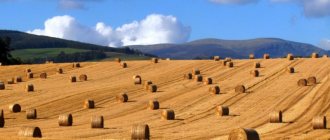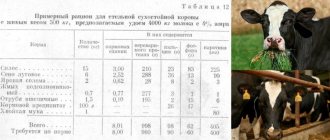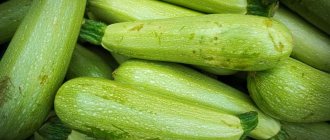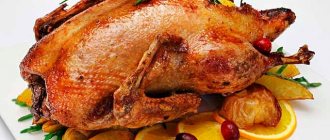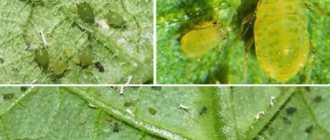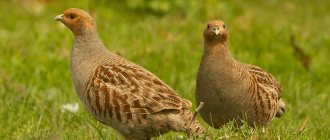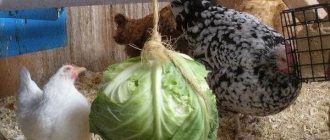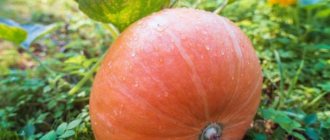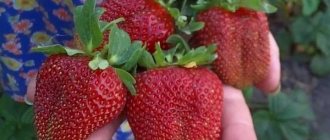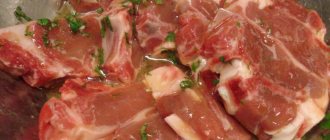Silage (Spanish silo) - succulent feed (silage feed) for farm animals; The word “silo” also refers to underground silo storage facilities.
In winter, it is an indispensable part of the diet for cows, horses and other farm animals, because silage contains many useful substances necessary in the cold season.
Photo:
Silage is a succulent feed that is prepared by canning greens.
Important! The main thing in ensiling is to create conditions so that lactic acid accumulation begins! The plant mass collected from the field and meadows is compacted into holes or trenches.
Over a certain period of time, the fermentation process begins, organic lactic acids (up to 2%) accumulate in the grass, which preserve the feed, protecting it from decomposition. Air access is of great importance.
If there is too much of it, the plants will begin to warm up, lose nutrients and mold will appear. So the amount of air access is reduced to a minimum!
The humidity of ensiled greens is maintained within 65-75%. If it is higher, lactic acid will accumulate slowly, and if the humidity is lower, the feed will not be able to compact tightly and there will be a lot of air inside.
To achieve the required moisture content, the feed is watered with plain water if necessary or straw and chaff are added.
Application
Silage is used in agriculture. It has high nutritional properties; its caloric content, vitamin content (contains carotene, vitamin C, organic acids) and dietary properties are comparable to fresh grass and is a valuable food product.
Silage improves digestion and promotes the absorption of other roughage. It is suitable for all kinds of herbivores and birds.
Such feed, stored in special silo storage facilities - special trenches, pits, silos, can be stored for several years.
To mechanize the storage of large volumes, silo towers are combined into silo buildings, which are part of the elevator.
Main silage crops
A variety of crops are used to make silage. They are divided into three groups:
- easy to silage;
- difficult to silage;
- non-siling in its pure form.
The first group includes green corn, sunflower, cabbage, rapeseed, beets, sorghum, carrot tops, cereal grasses, and legume-cereal mixtures.
Clover, sedge, sweet clover, and alfalfa are difficult to ensile. Tomato and potato tops, cucumbers, zucchini, melons, pumpkins, and soybeans are not suitable for ensiling in their pure form. Plants from the last group are harvested only in mixtures with easily silageable crops or with the addition of preservatives and starter cultures.
Suitable raw materials for silage are tops of garden crops, cabbage leaves, mixtures of legumes and cereals, grasses growing on pastures, and root vegetables. Protein-rich food waste (pulp, stillage, pulp) is also used for ensiling.
What are they made from?
Corn silage
Silage may vary depending on the crops it is made from:
- Corn is the most popular type of feed. Corn produces a high-quality product with a long shelf life. Corn silage can be made only from corn tops or together with cobs. It is always harvested during the period of milky-waxy or waxy ripeness.
- Meadow grass , healthy wild herbs, and waste are another good option for making silage. The final product is nutritious and of high quality.
- Rye, barley, and oats are usually sown mixed with legumes for subsequent ensiling. They go for ensiling during the period of milky-wax ripeness. They are stacked very tightly in silos. Corn silage is the most popular type of feed
- Alfalfa, legumes, nettles and clover are always ensiled together with grains (oats, rye, barley). By themselves, they are very useful and medicinal, but have low energy value. Legumes are harvested when young beans appear, and flowers are harvested during flowering.
- Sedge, reed and reed for ensiling are advantageous because they can be mowed 2-3 times per season.
The final product is quite good, considering its profitability. They are always collected before the panicle appears! Silage can also be made from sunflower, sudanese, sorghum, and chumiza.
Important! Animals love silage no less than hay or fresh grass. This is a very useful supplement that has a positive effect on the digestion of animals.
Wet feed ensiling
Ensilage is a technology by which canned green fodder is made from corn, grains and grass clippings. There is also a technology for chemical silage. It is used for harvesting difficult-to-silage grass and grain crops.
In winter, silage helps to compensate for the lack of fiber in most farm animals.
Ensiling wet feed increases its nutritional value. This allows you to increase the productivity of farm animals, primarily the milk yield of cows. Maximum preservation of nutrients is ensured using “cold fermentation” technology. It involves completely pumping out the air. The addition of chemical components will suppress the formation of lactic acid bacteria in wet raw materials.
The success of silage primarily depends on the type of silo chosen. That is why the method of harvesting in polymer sleeves has become widespread. It allows you to reduce the loss process to a maximum of 5%.
Advantages and disadvantages
Ensilage
You can prepare animal feed for the winter using different methods. But it is silage that currently has the most advantages.
During ensiling, the loss of nutritional components is only 10%, and during drying, plants lose 25-40% of useful components.
Not only fresh grass is used for ensiling, but also crops such as wheat, corn, grass and waste (tops) from vegetable crops. Silage can be made from the fastest growing green crops.
Interesting! For silage, you can use both specially grown crops and those that grow naturally in meadows and fields.
Ensiling allows you to obtain relatively cheap succulent feed for the winter or during the dry period of summer. Collection of green mass for silage can be carried out in any weather.
Among the disadvantages, it is worth noting that making silage is not very easy, and buying it is not cheap. In addition, you need to be able to store this product correctly, otherwise it will quickly deteriorate. Source:
What is Silo
Silage is a succulent feed that is prepared by canning greens with limited access to oxygen; the harvesting process is called ensiling. In winter, it is an indispensable part of the diet for cows, horses and other farm animals, because silage contains many useful substances necessary in the cold season. To understand what silage is, it is worth understanding how it is obtained.
Silage is a succulent feed that is prepared by canning greens.
Important!
The main thing in ensiling is to create conditions so that lactic acid accumulation begins!
The plant mass collected from the field and meadows is compacted into holes or trenches. Over a certain period of time, the fermentation process begins, organic lactic acids (up to 2%) accumulate in the grass, which preserve the feed, protecting it from decomposition. Air access is of great importance. If there is too much of it, the plants will begin to warm up, lose nutrients and mold will appear. So the amount of air access is reduced to a minimum!
The humidity of ensiled greens is maintained within 65-75%. If it is higher, lactic acid will accumulate slowly, and if the humidity is lower, the feed will not be able to compact tightly and there will be a lot of air inside. To achieve the required moisture content, the feed is watered with plain water if necessary or straw and chaff are added.
Harvesting technique
The technology for making silage is called ensiling. To make silos, special pits, trenches, and towers are used. Holes and trenches are always dug in clay soil and lined with cement to prevent moisture from passing through the ground.
The preparation takes place in several stages:
- The green mass is collected from the field and brought to the harvesting site.
- Cereals, meadows, and legumes are crushed to 3 cm, and corn and sunflower to 5 cm.
- The resulting crushed mass is compacted into silo pits, trenches or towers. This entire process should take a minimum of time.
Optimal cover of the silage pile
- A layer of moistened clay 15-20 cm thick is poured on top of the green mass.
- If silage is prepared in the cool season, for example, in the fall, so that it does not start to freeze in the pit, straw and earth are also laid on top of the clay.
- Over the pits or trenches with the harvested silage, awnings, tents, and roofs are installed so that snow and rain cannot get inside.
- From corn, young grass, sunflower, grain grasses, silage is ready in 2-3 weeks. Legume silage takes longer to prepare and can only be used after 2-3 months. Only after this can you start testing it and selling it or using it to feed animals.
Important! Only fresh, high-quality silage can be used. Moldy product should not be given to animals, because it can cause severe stomach illnesses, especially for horses!
Making silage: overview of crops used and recommendations for feed use
Nutritious greens are obtained by canning or fermenting forage plants. Freshly cut or dried tops, stems and leaves are preserved in pits, trenches, polymer sleeves, towers and other structures. The technology for preparing feed largely depends on what the silage is made from.
The following are chosen as raw materials to obtain a high-quality product:
- corn;
- kale;
- sunflower;
- winter rye;
- rape;
- sorghum.
The main condition for choosing silage crops is the presence of a sufficient amount of sugars in them. After all, it is these compounds that are responsible for lactic acid fermentation in green mass.
Corn is most suitable for preparing food products. Although legumes, as well as tops of carrots, watermelon and beets, are successfully combined with it. However, it is recommended to use it independently. At the same time, oilseed radish and white mustard have high nutritional value. The collection of these plants for making silage is carried out 40-45 days after the appearance of the first shoots, but before the start of budding. But sunflower goes harmoniously with vetch, oats, peas, lupine, barley and beans.
Moreover, there is another group of silage crops that contain a small percentage of sugars. For this reason, they are prepared in the form of combined mixtures.
Add to sunflower, rapeseed, corn and winter rye:
- clover;
- alfalfa;
- soy;
- vetch (or other perennial grass);
- sedge;
- lupine;
- sweet clover
If there are very few light-silage plants, then all kinds of starters or preservatives are introduced into the substrate. The resulting juicy mass is used to feed cows, chinchillas, nutrias, pigs, goats, sheep and rabbits. To get a high-quality product, it is important to learn how to make silage at home.
Food waste rich in protein (pulp, pulp or stillage) is also used as a basis for preparing nutritious food. At the same time, these can be perennial grasses, legumes and cereals, or tops of other garden plants.
Silage cutting season
For each type of plant, the harvesting time is strictly individual, since their development and maturation phases are different. The crop must be mowed at a time when it is maximally rich in chemical compounds necessary for fruitful fermentation. Taking these features into account, agronomists distinguish several categories for harvesting silage crops:
- Corn. During the transition of grain from milky ripeness to waxy ripeness.
- Winter rye. Initial stage of heading.
- Clover. When the buds bloom.
- Sunflower. At the beginning of flowering and before the flower rosettes bloom, but not more than 30%.
- Soy. After the fruits have browned.
There is a pattern in this list: cereal grasses are harvested during the heading period, and legumes and other grains are harvested at the initial stage of waxy ripeness of the grains. Now it's time to look in detail at how to make silage with excellent quality characteristics.
To determine the moisture level of the plants, the greens are twisted. If juice appears on the folds, then the indicator is normal. Foliage that is not wet enough will have a limp appearance, while foliage that is too juicy will begin to release liquid when cutting.
Quality control
After the silage has been stored for the required time and should have been prepared, it is necessary to carry out quality control. Not a single silage harvest takes place without this final procedure.
In order to determine how good a product is, it is evaluated according to several indicators:
- Presence of mold and rot. If there are any, the feed is considered spoiled and is not suitable for sale.
- Acidity and percentage of lactic and acetic acid. This is done using a special indicator or by smell. If the smell is apple or bread, then everything is fine. If there are vinegar notes, then the silage contains a lot of acetic acid (more than the norm of 30%). A manure smell indicates an abundance of butyric acid. This happens when silage raw materials contain spore-bearing bacteria. This product should not be fed to animals.
- The color of quality silage should range from olive to green. The darker the color, the lower the quality.
Interesting! Lactic acid bacteria necessary for silage develop at temperatures from +5 to +55 degrees. Therefore, the temperature inside the silage is rarely controlled.
Good silage can be sold. In large productions it is packaged in sealed bags, and in small ones it is simply sold out of the pit where it was procured.
Optimal mowing phase
One of the factors influencing the nutritional value of silage is the period of mowing the crop for ensiling. Each plant has the most favorable development phase for use in silage feed.
So, to make silage, the corn plant is harvested at the stage of milky-waxy ripeness of the grain. It is then that corn is easily ensiled and can lose only 10% of its nutritional properties during harvesting. In the same phase, sorghum is cut.
The best time to harvest sunflowers is when the plant's inflorescences are 30% open. If you miss this point, the fiber content in the sunflower will increase, and animals eat such food less willingly.
Annual silage legumes are harvested in the phase of milky-waxy grain ripeness in the lower third, annual legumes - during the period of bud protrusion.
Fodder lupine for silage is mowed when grains are formed. Clover ensiles well during the flowering period, cereals - at the beginning of heading.
How much to feed cows, pigs and horses?
Silage as feed is a fairly valuable substitute for fresh grass, but it can only be given in strict dosage. For cows, up to 8 kg of silage per 100 kg of body weight is allocated per day.
Young animals eat silage only from 2 months of age. At first it is given in small quantities, and by the year the amount increases to 8-10 kg/day.
Adult pigs can eat up to 3-4 kg per day, sheep - 1-2 kg/day. Horses also love silage; about 6-8 kg are consumed per head per day.
Measures to obtain high-quality haylage
In short, the success of quality haylage is to lower the pH as quickly as possible within the first few hours of the silage process.
It means:
- organic fertilizer: maximum 25-30 cubic meters/ha as a one-time action (fungal spores)
- healthy young grass and harvesting with a minimum of dirt (reduced microbial contamination)
- drying (target: 35-45% dry matter)
- maximum possible compaction (especially edges, use of silage spreaders, wetter grass at the end)
- cover as quickly as possible (bottom film + main film + tires over the entire area + bird protection + sandbags)
- silage removal speed: >1.5 m in winter, >2.0 m in summer
- regular monitoring of the silo trench
- use of an effective preservative
Storage
Silage pit
Silage is usually purchased for large and small farms. In order for it to be stored well, it is necessary to provide it with the right conditions.
The best option is a silage pit, like the one in which silage is made.
It is not made very deep, but such that all the purchased mass fits. It is advisable that the base and sides are concrete, then storing the silo will be much easier.
Interesting! Frozen silage can be added to animal mashes or given separately, but only after thawing!
The purchased silage is immediately poured into such pits and covered with a special silage polymer film to prevent air from entering inside.
If you need to store it all winter, put hay and soil on top of the film; they will protect the product from freezing and spoilage.
We must not forget that with access to air, it is stored for very little time - up to a week or even less, so transportation and sealing in a new silo for storage must be carried out in a short time.
